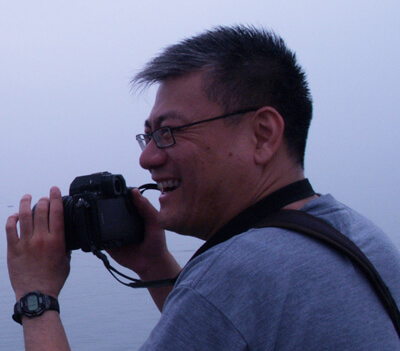International award winning documentary photographer Larry Louie leads a dual career. In his optometry clinic, he is Dr. Larry Louie, working to enhance the vision of people from all walks of life in the urban core of a North American city. On his travels, he is a humanitarian documentary photographer, exploring the lives of remote indigenous people, and documenting social issues around the world. As an optometrist, Larry adjusts people’s visual perception. As a photographer, he seeks to adjust people’s view of the world. Either way, he is interested in things that exist outside the regular field of vision.
Larry’s photographs have often been described as realism at its best. There is a story waiting to be told in every image. Sarah Cho, competition director of the IPA/Lucie Awards describes Larry’s photographs as “captivating and sincere and reflect his passion for the medium,” adding, “Larry Louie has a very distinctive style, straddling the fine line of a photo journalist and documentarian. His images are as rich and evocative as the subjects (on) which he focuses.” His photographs show the strength and perseverance that mark people the world over, revealing the light sometimes found in dark places.
Larry' s work to document the lives of people around the world has resulted in a vast archive of images. His work has received international recognition and awards including the IPA Lucie Award; National Geographic Photo Essay Award; and Humanitarian Documentary Grant with the World Photography.
As an optometrist and photographer, Larry is avid supporter of Seva Canada, an international non-profit organization who is a part of VISION 2020, the global initiative for the elimination of preventable and avoidable blindness in the world by year 2020.
Source: www.larrylouie.com
Interview with Larry Louie
All About Photo: When did you realize you wanted to be a photographer?
Larry Louie: I knew when I was about 16 when I received my first real camera and I was experimenting exposures.
AAP: Where did you study photography?
LL: Self taught.
AAP: Do you have a mentor or role model?
LL: I do not have a mentor, but I have master photographers whose work I greatly admire and I study their amazing portfolio of works: Josef Koudelka, Sebastiao Salgado, James Natchwey.
AAP: How long have you been a photographer?
LL: I have been regularly photographing since 18 years of age but in regards to the documentary work, only for the last 8 years.
AAP: Do you remember your first shot? What was it?
LL: My first shot that I liked was the color image of 2 women taken in Jodphur, India. I call it the Blue City image because of the predominating blue color of the city. This image was placed second in a National Geographic Traveler magazine photo competition.
AAP: What or who inspires you?
LL: Great work that has passion in the subject. That is why I like the works of the above artists I mentioned.
AAP: How could you describe your style?
LL: I like B&W documentary work that evokes one's curiosity about mankind and his struggle with the surrounding environment.
AAP: Do you have a favorite photograph or series?
LL: I like 2 of my latest series:
"A Working Day in Dhaka" and my latest series
"Tondo, Manila" (will be up on the web within this month).
AAP: What kind of gear do you use? Camera, lens, digital, film?
LL: I use Canon 5D Mark3 bodies, 24mm f1.4 prime lens, 85mm f/1.2 prime lens, and 24-105mm f/4 zoom lens.
AAP: Do you spend a lot of time editing your images? For what purpose?
LL: I don't do too much editing. I do not crop my images and very minimal photoshop besides converting it into black and white and some burning and dodging. I do most of my editing the week after I return on a trip. The images are used for my website, to produce prints, calendars for fund raising purposes.
AAP: What are your projects?
LL: Please go to my
website. My latest projects have been concentrated on the working poor and people who are stuck in the bonds of poverty, especially children born into poverty and child laborers.
AAP: Favorite(s) photographer(s)?
LL: Josef Koudelka, Sebastiao Salgado, James Natchwey.
AAP: What advice would you give a young photographer?
LL: Photograph what gives you passion. The best work will come through. Shoot, shoot, shoot.
AAP: What mistake should a young photographer avoid?
LL: Being cliché. One should be original.
AAP: An idea, a sentence, a project you would like to share?
LL: My wife and I are working presently with an organization named
"Philippines Community Fund" whose goal is through education to enable a generation of children to escape from the cycle of poverty to which they are born into, and in doing so create a better and more sustainable life for them and their family. PCF today funs a four storey school in Tondo, Manila providing education, food, healthcare, and other support services for nearly 600 children from the nearby garbage dump and cemetery.
AAP: Your best memory as a photographer?
LL: To be able to help and raise funds and bring attention to issues that makes a significant difference in the lives of the people we photograph.
AAP:The compliment that touched you most?
LL: A thank you and a smile from the people who we touched during our visits and who in return touched us with their graciousness.
AAP:If you were someone else who would it be?
LL: I am happy with who I am and what I do.
AAP: Your favorite photo book?
LL: "The Sahel" by Sabastiao Salgado.
AAP: Anything else you would like to share?
LL: No, I would like to thank you for your interest in my photography.
